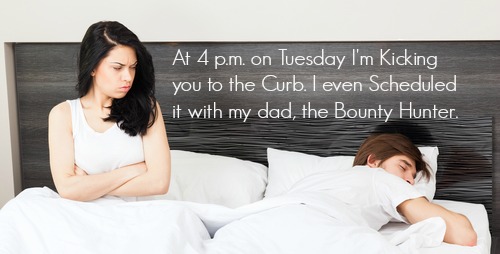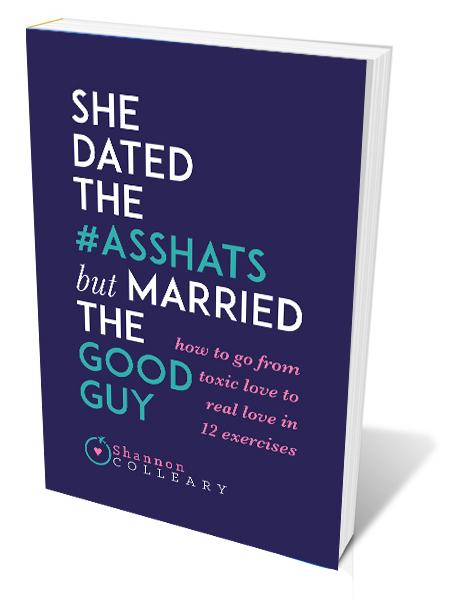
In figuring out how to leave an abusive relationship we need to understand that addiction to a person is no different than addiction to a substance.
All of the same symptoms can take hold:
- Descent into a shame-spiral about the addiction.
- An inability to control your own behavior often participating in self-destructive, compulsive and furtive activities.
- The loss of positive relationships with other family and friends.
- Poor performance at school or work. And the list goes on.
Beating your addiction to, what I call, an Asshat isn’t just mind over matter. But the first and most essential step toward recovery does come from your mind; which is admitting to yourself (and then to another person and/or supportive group) that you have a problem.
Next, it’s time to make a plan for quitting, seek help and prepare yourself for the challenges you’ll meet along the way.
______________________________________
Step One: Deciding to Quit
1. Write down the harmful effects of your addiction.
How has addiction to the Asshat affected you mentally?
- Are you embarrassed by it?
- Has it preoccupied you to the extent that you’re not doing well at work or in school?
How has it affected you physically?
- Are you so upset you’re forgetting to eat?
- Or eating too much?
- Are you drinking more than you should?
- Are you forgetting to exercise?
- Have you given up on self-care?
How has it affected your other relationships?
- Have you lost friends because of your addiction to the Asshat?
- Are there rifts with family members?
How has your addiction affected you emotionally?
- Are you depressed?
- Ashamed?
- Do you feel disconnected from the things you used to love to do?
- Write everything down. And be specific.
2. Make a list of positive changes you want in your life
This is a powerful tool in learning how to leave an abusive relationship. Imagine what it might be like if you were no longer addicted to the Asshat? Imagine not worrying anymore where the Asshat is and what he or she is doing.
What would that look like? Really draw that picture in your mind.
- Would you sleep better?
- Feel freer?
- Would you start taking dance lessons again?
- Would you start traveling again?
- Would you spend more time with friends and family who support you?
- Would that sickening feeling of dread that resides in the center of your chest when you think about the Asshat go away?
- Would you like yourself better and even feel proud of yourself?
Write down all the ways your life would be without the addiction to your Asshat. You can even make an aspirational collage of images that reflect the peace, joy and love you could invite into your life without your addiction, and mount it somewhere you can see it every day.
3. Write down your Quitting Commitment.
Writing a list of important reasons to quit your addiction can help you when you’re feeling tempted to call the Asshat and get sucked back into his/her life.
Your reasons for quitting have to be stronger than your reasons for staying with the Asshat, and when we’re in the throes of our compulsive behavior, sometimes it’s necessary to have a list we can actually look at, hold and read aloud to strengthen our resolve.
Here are some examples of solid reasons to quit your addiction:
- Decide you’re quitting because you want to have children one day who can count on a stable loving home.
- Decide you’re quitting because you don’t want to feel isolated anymore and want to see more of your friends and family.
- Decide you’re quitting because you want to be more effective in finding a career and then maintaining and growing your career.
- Decided to quit because you want to feel good about yourself and you want to love yourself again.
_______________________________
Step Two: Making a Plan to Quit
4. Be real with yourself about what quitting your addiction to your Asshat looks like.
When we’re quitting a substance, like alcohol or drugs, complete abstinence is the goal. If we have an eating addiction, that’s trickier because we have to eat to survive. Quitting an Asshat is somewhere in the middle.
I believe that breaking an addiction to an Asshat should be complete abstinence, which means removing yourself entirely from that relationship.
Having said that, I had to quit my Asshat in stages. For me, the first stage included:
- Starting the Al-Anon 12-step program
- Abstaining from spying on my Asshat to see if he was being faithful to me
- Abstaining from looking through his things to find evidence of his cheating
- Forcing myself to make plans with other people and not just waiting around for him.
I don’t recommend this highly, as it took me five years to get out of my abusive relationship, but I will say this, just stopping those specific self-destructive behaviors helped my self-esteem. Because even if he wasn’t behaving morally, I was, and that meant a lot.
I’m going to tailor the next steps around you permanently ending your addiction to the Asshat and the abusive relationship. But you can adapt the steps according to your own specific goals.
5. Set a concrete date to quit your addiction.
You don’t want to set the date for tomorrow or beyond a month from now. You’re going to want to select something in the middle. You need time to do the steps above to prepare yourself mentally, but you also need to set a date that isn’t too far in the future so you don’t waver, overthink things and lose momentum.
Wiki How offers some suggestions that I like:
“Consider picking a date that’s meaningful to you, to help motivate you. Your birthday, for example.”
“Mark the day on your calendar and announce it to those close to you. Build it up so that you won’t be likely to back down when the day arrives. Make a firm commitment to yourself that you’re going to quit on that date.”
6. Seek personal and professional support.
Seeking a professional therapist or perhaps a 12-step support group is invaluable. When it comes to mental and emotional health we’ve got to come out with all guns blazing.
7. Identify your triggers.
When it comes to addiction, we all have triggers that can weaken our resolve.
When I was attempting to leave my last Asshat relationship, I had to make a promise to myself not to see, text, email or speak to my Asshat for at least a month, because any contact with him triggered my addiction.
I also had to avoid places he and I frequented, like restaurants, movie theaters and shops. Because those were triggers.
I had to rid my apartment of all evidence of the Asshat, storing or throwing away gifts he’d given me, letters he’d written, articles of his clothing that were still there.
One great tool to use when it comes to triggers is not just to get rid of them, but also to replace them with something else.
While staying away from the Asshat, make plans with other people. Go to new restaurants and theaters and shops you’ve never been to.
Replace his items in the house with other things you love, like plants, books, framed photos that don’t include the Asshat. Change the layout of your home and bedroom to make it feel fresh and new.
____________________________________________
Step Three: Quitting and Handling Withdrawal
8. Stop the addictive behavior as planned when your quitting date arrives.
Just assume the first week or so are going to be excruciating. Coming down off of an emotional addiction can feel like dying. I spent practically the entire first month sobbing. But I kept myself as busy as I possibly could and I suggest you do the same.
See your therapist, go frequently to your support group, and commit to a sponsor to keep you busy and moving forward in your recovery. Surround yourself with people who know about what you’re doing and who will be supportive and encouraging.
9. Steer clear of your triggers.
When I asked my Asshat not to contact me for one month, I was able to stick to it because my Al-Anon sponsor called me every morning at 8 a.m. to pep talk me into just one more day without contact with my addiction.
I took it “One Day at a Time,” which is an incredibly practical, helpful slogan to adopt. Set up a therapist, sponsor or friend who might be willing to do this for you.
Make sure you don’t allow yourself to look at memorabilia of your abusive relationship. Don’t stalk your Asshat online or visit the locations the two of you spent time together. You cannot afford to indulge ANY SENTIMENTALITY!
10. Don’t give in to rationalizations!
Addiction lies. It comes to us in the dead of night when we’re loneliest and whispers in our ear. Things like this:
“He wasn’t so bad. He says he loves me. And who says there’s anyone better out there? Maybe all men/women lie, cheat and don’t commit.”
Or
“She says she’s going to change and this time she seems to really mean it. People do change. Who’s to say she can’t?”
Or
“If I don’t marry this Asshat who knows how long it will be before I meet someone else? By then I may be too old to start a family.
These are all lies. This is addiction lying to you. Do NOT give in. When you feel yourself beginning to cave, go back to your list of reasons to quit your addiction. Think about why quitting is more important than staying addicted. Lean heavily during these times on your therapist, your 12-step sponsor, your supportive community and me.
11. If you relapse don’t give up.
As anyone who has worked a 12-step program for addiction will tell you, relapses are bound to happen. There’s no point in beating yourself up and heading into a shame-spiral that will only keep you stuck in the addiction. Be kind to yourself and encouraging, as you would be to a friend or even a little child. Give yourself a break. Empathize with yourself and give yourself credit for fighting the good fight.
Then look into why you relapsed? Did you have a particularly stressful day that caused the relapse? Did you encounter and engage in one of your triggers? How can you learn from this and use that knowledge to recommit to recovery having more experience to draw from?
That’s it for now. I’m so glad you’re here. This is a safe place to do the brave things that need to be done. Xo Shannon
______________________________________________
 If You’re Struggling in a Toxic Relationship:
If You’re Struggling in a Toxic Relationship:
Sign-up for Shannon’s occasional NEWSLETTER, and be sure to pick up Shannon’s book HERE or click on the photo. It’s a game changer!

2 thoughts on “How to Leave an Abusive Relationship Using 11 Actionable Tasks!”
This program is so helpful to me so far! I got rid of my asshat 3 months ago, after 6 years of feeling like i must be going crazy…but I can still talk myself into wanting to stay friends, texting, keeping those lines of communication open. I have to keep telling myself over and over again all the things he did to hurt me. I have made many many loaves out of crumbs, lol, but i never wanna do that again! Looking forward to the support this program will give me to hang in there…Thank you!!
Oh Victoria, this is so wonderful this makes me feel like I’m of use! xoS
Comments are closed.